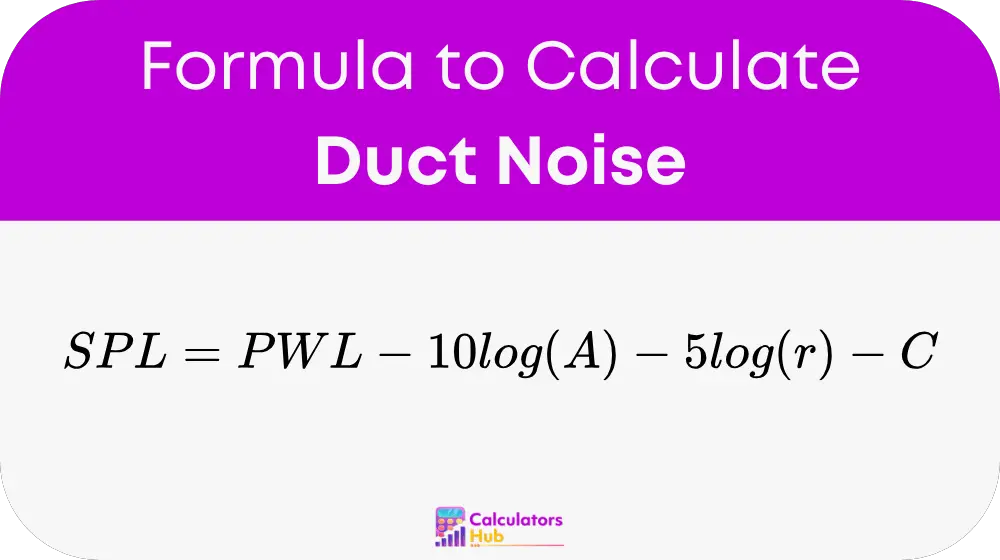The Duct Noise Calculator measures the sound level you hear from a duct system at a specific spot. It takes the noise source strength, room setup, and distance to tell you the sound pressure level in decibels (dB). This is great for real-life decisions, like designing quiet ventilation, choosing silencers, or keeping rooms comfortable.
This calculator helps you plan systems that won’t disturb people, whether in homes, offices, or factories. It’s reliable for important tasks, like meeting noise rules or improving air quality without extra sound. Ready to see how it’s calculated? Let’s check out the formula next.
Formula for Duct Noise
The formula for calculating duct noise is:

Where:
- SPL = Sound Pressure Level at the receiver point (dB)
- PWL = Sound Power Level of the source (dB)
- A = Room absorption (sabins) = α × S
- α = Average absorption coefficient (0 to 1, depends on room materials)
- S = Total room surface area (ft²)
- r = Distance from source (ft)
- C = Directivity factor (typically 0-6 dB)
This formula comes from sound engineering. The PWL is the noise the fan or duct makes, while A, r, and C adjust for the room and how sound spreads. Now, let’s make it easier with a table.
Quick Reference Table for Duct Noise Levels
Why calculate every time? This table shows sound levels for common setups with a PWL of 80 dB and C of 2 dB. It’s a fast way to check without math.
| Room Size (ft²) | Absorption (α) | Distance (ft) | SPL (dB) |
|---|---|---|---|
| 500 | 0.2 | 5 | 58 |
| 1,000 | 0.3 | 10 | 52 |
| 2,000 | 0.4 | 15 | 47 |
How to Use the Table
- Pick your room size, absorption, and distance.
- Check the SPL value.
- Use it to plan noise control.
This table helps with searches like “duct noise in 1,000 sq ft room.” For exact results, use the formula. Next, let’s try an example.
Example of Duct Noise Calculator
Suppose your duct fan has a sound power level (PWL) of 85 dB. The room is 800 ft² with an absorption coefficient (α) of 0.25. You’re 10 feet from the duct, and the directivity factor (C) is 3 dB. You want to know the sound level. Here’s how to do it:
- Calculate room absorption:
A = α × S = 0.25 × 800 = 200 sabins - Plug into the formula:
SPL = PWL – 10log(A) – 5log(r) – C
SPL = 85 – 10log(200) – 5log(10) – 3 - Calculate step-by-step:
- 10log(200) ≈ 23
- 5log(10) = 5
- SPL = 85 – 23 – 5 – 3 = 54 dB
So, the sound level is 54 decibels. This fits acoustic standards and helps you decide if it’s quiet enough.
Most Common FAQs
Loud ducts can bother people and break noise rules—keeping it low improves comfort.
Below 50 dB is quiet for most rooms—over 60 dB might need silencing.
Check the fan or duct specs—manufacturers list the sound power level in dB.